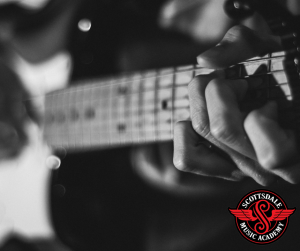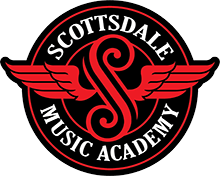 Best Chord Structures for Rock ‘n Roll Songs
Best Chord Structures for Rock ‘n Roll Songs
At Scottsdale Music Academy, our instructors have a blast teaching the students (both kids and adults) how to play guitar, bass, piano, drums and singing. When you put ‘em all together with the right people, you can rock out to your favorite rock songs.
But where do you start if you want to write your own original rock ‘n roll songs? Picking out a notes to create a warm melody is a start, but knowing how to play chords for basic rock ‘n roll songs will take you further. Try listening to some of your favorite guitar rock songs? You hear a pattern of chords that make up the main structure and usually repeat in the song. That’s called the chord progression. Let’s explore this a bit.
Understanding Chord Progressions
Chord progressions for rock songs can be fairly predictable; after all, rock n roll has been churning out shaking grooves for the last 60 years or so. Many of the 1950s early attempts at rock n roll used basic chord progressions like E-A-D (think Buddy Holly songs) or D -Bm–G-A (think doo-wop songs). These progressions have become known to listener’s ear, and someone who listens to good rock n roll can often pick out where the song is headed after hearing it once or twice.
Chord progressions are put together in a certain pattern to fit the song structure, or maybe offer up a certain mood or temperament for the song. The chord sequence might help the singer hit the notes in just the right way.
Popular Rock n Roll Chord Progressions
So what kind of chord sequences do you like best? Let’s look at a few of the most familiar chord progressions for playing rock and roll songs.
2 Chords
- Em-D – Finding the right beat and the right melody over a two chord sequence can be a powerful thing. Em-D is a good one, much of REM’s early songs are built around these chords.
- Am-G – Similarly, Am-G on repeat can be very effective with the right vocal melody. In fact, a 1960s garage rock classic “Pushin’ Too Hard” is entirely on the Am-G sequence.
- G-C or G-D – Rock songs are super fun and easy with either G-C or G-D.
3 Chords
- E-A-B (also known as I-V-VII or 1-5-7) – Many blues songs are built on this chord progression, using a major or minor E to start the blues for 4 or 8 bars, then moving on to A for 4/8 bars, then to B, and to the turnaround back to E.
- D-A-G – Similar to the one above Many guitar pop songs use this progression. All major chords that sound great together, I’ve often said to friends, with these three chords you can conquer the musical world. The magic comes in using a strong melody and interesting arrangement with these chords.
4 Chords
- G-Em-C-D – the chord progression pictured above steals from the doo wop of the 1950-s, but with the right amount of rock n roll attitude, you can push this one far far ahead of doo wop.
- D-Bm-G-A – Transposed up to a D, this is the same four-chord progression as above, but hits a lighter note with the chords involved.
- E- F#m-G#m-A – This chord progression is fun to play. You can play this using barre chords for a rougher harder sound, or play with open high B and E strings for a lovely ringing guitar sound. Ask your Scottsdale Music Academy guitar instructor for knowing how to play this one best for your songs.
Practicing these progressions over time will help you to start writing your own rock n roll songs. If you need extra practice, call us to take guitar lessons in Scottsdale!
